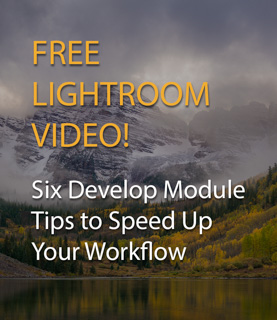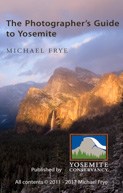Light and Weather
by Michael Frye | May 26, 2020 | Composition, Light and Weather
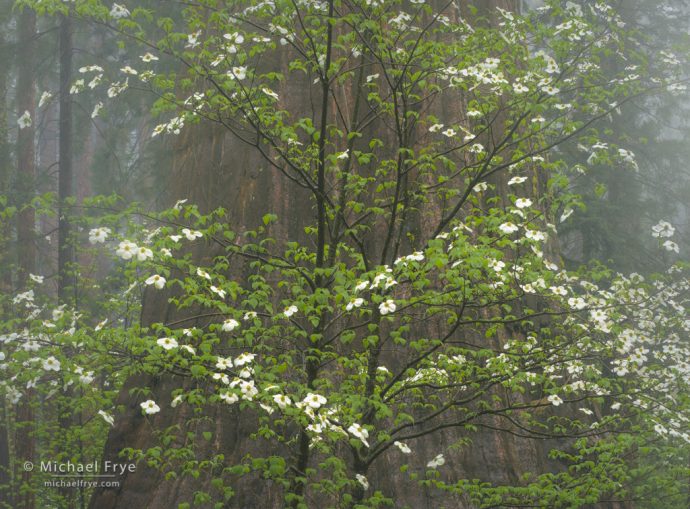
Dogwood and giant sequoia in the fog, Sierra Nevada, California. Fog is a wonderful complement to forest scenes; here, some ephemeral fog lasted just long enough for me to capture this image. 70mm, polarizer, 0.7 seconds at f/16, ISO 100.
People seem to love trees and forests. I know I do.
But forests can be difficult to photograph. Natural forests are usually a study in chaos, with haphazard arrangements of branches, trunks, logs, and leaves. There’s an organic order to all that, with trees and understory plants growing to take advantage of small patches of sunlight, and a cycle of birth, growth, death, and decay.
But visual order can be hard to find amid all that clutter. The chief challenge in photographing forests is usually finding a way to simplify things, and make order out of chaos.
(more…)
by Michael Frye | May 19, 2020 | Light and Weather
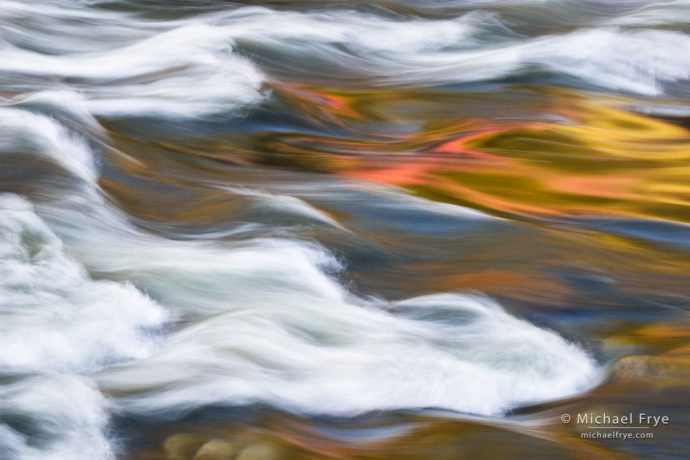
Redbud reflection in the Merced River, California
I made this photograph in March of 2004, with a 6-megapixel Canon 10D. That was my first digital camera, purchased only about nine months earlier, in the summer of 2003. The low resolution made this camera unsuitable for “serious” work, so for about two years I carried around both the Canon 10D and my Mamiya 645 film camera. I used the Canon for snapshots, and, when time allowed, to capture digital versions of my film images, so that I only had to scan the film captures when I really needed the extra resolution (like when making prints, or sending files to publishers).
I quickly learned to love digital capture. It was just so much easier: I could see the results right away, use the histogram to check the exposure, and magnify the image to see if everything was in focus. When photographing moving water I didn’t need to guess about the right shutter speed because I could try several, see the effects immediately, and dial in the shutter speed that best suited the situation. I found that the digital camera invited experimentation and creativity, because I didn’t have to pay for film and processing, and could see and refine the results of an experiment in the field. And, as if all that wasn’t enough, the dynamic range far exceeded transparency film, so the resulting images looked less harsh and more luminous. Resolution aside, when I compared images from my Mamiya and my Canon, I almost always preferred the ones from the Canon.
(more…)
by Michael Frye | Apr 5, 2020 | Light and Weather
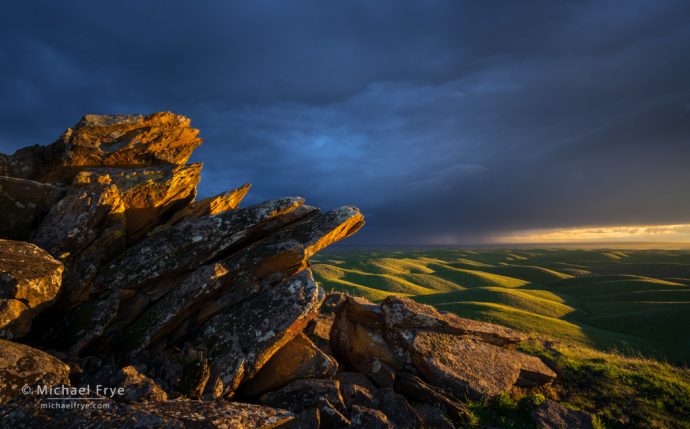
Late-afternoon light in the Sierra Nevada foothills. Most of the photographs I made this afternoon didn’t include a foreground. But I saw this rock outcrop, and kept it in mind for the right opportunity. That opportunity came when the sun slid underneath the clouds and highlighted the jagged forms of the outcrop. 16mm, 1/20th sec. at f/16, ISO 400.
Our winter got off to a wet start in late November and early December, but then fizzled. We hardly got any precipitation during most of December, January, and February – traditionally the wettest months of the year in California, when we get the bulk of our annual rainfall.
That pattern changed a bit in March, with a few good storms to help replenish the previously-anemic Sierra snowpack. And one of our largest storms since last spring is moving into California right now, with forecasters predicting three to four feet of snow above 7,000 feet. Our precipitation for the water year (October 1st through September 30th) will still be below average, but these early-spring storms should, at least, leave us with a decent snowpack for this time of year, with closer-to-normal runoff in our rivers and creeks over the next couple of months, and a more typical summer in the high country.
(more…)
by Michael Frye | Mar 22, 2020 | Composition, Light and Weather
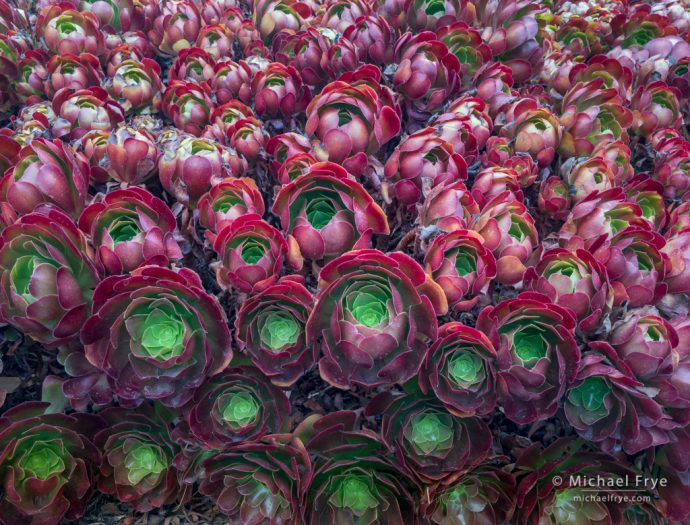
Huntington Gardens – an irresistible pattern! Captured with my iPhone, like all the photos in this post.
I had planned to write this post before the whole coronavirus lockdown. After all, even in “normal” times, many photographers only pick up their cameras when they’re traveling, or taking a workshop. Then when they go on that special trip they’re rusty, and it takes several days just to get back in the groove and start seeing better.
But it doesn’t have to be that way. Here are two simple tips for keeping your photography eye sharp while you’re stuck at home – and even once you go back to your normal routine.
(more…)
by Michael Frye | Mar 15, 2020 | Light and Weather
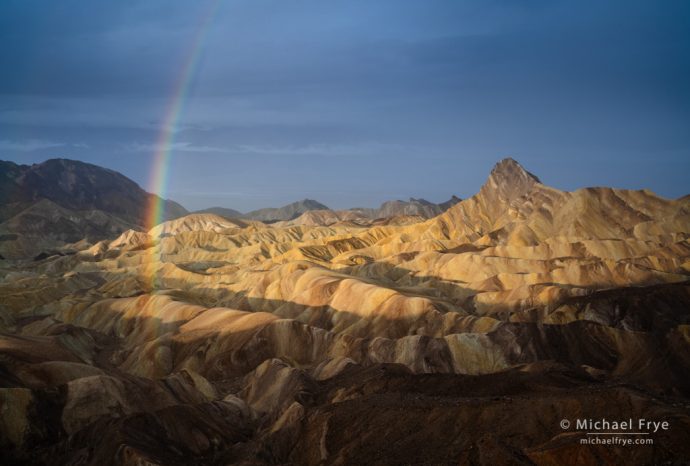
Rainbow over badlands, Death Valley
Claudia and I just got back from two trips to Death Valley. That journey started with a workshop I taught for Visionary Wild, with co-leader Jerry Dodrill. Although Jerry and I didn’t know each other well beforehand, it turns out that we have similar approaches to photography and teaching, plus Jerry is super nice – along with being a wonderful photographer and teacher. We got along really well, and had a great group of participants, so it turned into a really fun workshop.
Claudia actually had to return home early to deal with a minor pet crisis. When I got home after the workshop we saw that Death Valley might be getting some interesting weather: rain and higher-elevation snow, with a flash flood watch. We’d never been in Death Valley during weather like that, so we re-packed the car and drove right back. Camping in the rain with possible flooding – sign me up!
(more…)
by Michael Frye | Feb 23, 2020 | Light and Weather

Sunset in a San Joaquin Valley marsh. We’ve had some beautiful sunsets this winter in that other valley – the Central Valley of California – where the wide horizons can showcase the colorful skies. I made this exposure about 45 minutes after sunset. By then it was so dark that my eyes could barely see the color, but the camera could capture it easily.
Which is more important, the light or the subject?
I would say it’s the light – hands down. After all, we don’t really photograph objects; we photograph the light reflected off of objects. Light has everything to do with how a subject looks, and whether it will make an interesting photograph or not. A great subject with ordinary light will make an ordinary photograph. An ordinary subject with great light could make a great photograph.
(more…)







